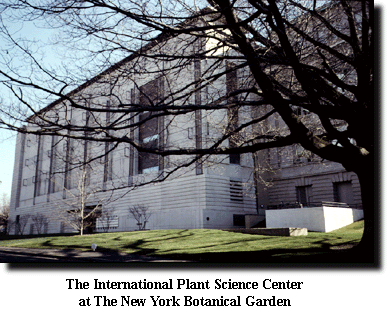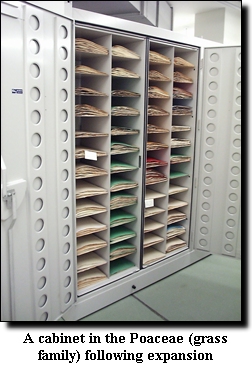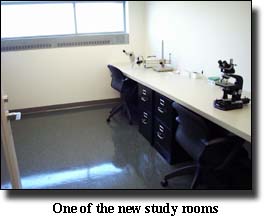
The International Plant Science Center
New Home for the Herbarium and Library

In a comprehensive, two-year strategic planning process begun in the early 1990s, The New York Botanical Garden developed a Master Plan intended to clarify and document the institution's priorities and commitments for the future. The construction and endowment of a Plant Science Center to allow expansion of the crowded Herbarium and LuEsther T. Mertz Library collections, to store the collections under state-of-the-art environmental conditions, to provide space for their growth, and to provide nine study rooms for scholars visiting the Herbarium and Library emerged as the centerpiece of the Master Plan.
 In
recognition of this project's status as a national priority, the United
States Congress, with leadership from Senators
Daniel Patrick Moynihan and Alfonse M. D'Amato, made public funds available
through the United States Department of Agriculture.
Additional support for the Plant Science Center was received from the LuEsther
T. Mertz Charitable Trust; Edward P. Bass of the Philecology Trust; Shelby White
and Leon Levy; Arthur and Janet Ross; The Starr Foundation; the National
Science Foundation (DEB-9710105
for a mobile storage system and for new cabinets; supplement to DBI-9808824
for microscopes and computers for visiting scholars); The Prospect Hill Foundation;
The Bank of New York; J.
P. Morgan and Co., Incorporated; New York City; and New York State.
In
recognition of this project's status as a national priority, the United
States Congress, with leadership from Senators
Daniel Patrick Moynihan and Alfonse M. D'Amato, made public funds available
through the United States Department of Agriculture.
Additional support for the Plant Science Center was received from the LuEsther
T. Mertz Charitable Trust; Edward P. Bass of the Philecology Trust; Shelby White
and Leon Levy; Arthur and Janet Ross; The Starr Foundation; the National
Science Foundation (DEB-9710105
for a mobile storage system and for new cabinets; supplement to DBI-9808824
for microscopes and computers for visiting scholars); The Prospect Hill Foundation;
The Bank of New York; J.
P. Morgan and Co., Incorporated; New York City; and New York State.
Designed by the firm of Polshek and Partners Architects, the Plant Science Center, which has been under construction since the fall of 1997, is a five-story, 70,000-square-foot facility constructed as an addition to the beaux arts-style Museum Building.
 Richard
Jansen of Richard Jansen Architects (39 West 53 Street, New York, New York)
served as Project Architect for Equipment. From his work with several museums,
he brought valuable experience with compact storage systems for museum collections.
His job was to work with the Herbarium staff to determine the ideal size for
each bay (i.e., the number of cabinets in each row and the number of mobile
rows per stationary row), to work with the design team to assure that the Plant
Science Center met the Herbarium requirements, to work with potential vendors,
and to inspect the compact storage system following installation.
Richard
Jansen of Richard Jansen Architects (39 West 53 Street, New York, New York)
served as Project Architect for Equipment. From his work with several museums,
he brought valuable experience with compact storage systems for museum collections.
His job was to work with the Herbarium staff to determine the ideal size for
each bay (i.e., the number of cabinets in each row and the number of mobile
rows per stationary row), to work with the design team to assure that the Plant
Science Center met the Herbarium requirements, to work with potential vendors,
and to inspect the compact storage system following installation.
William P. Lull of Garrison/Lull, Inc. (Princeton Junction, New Jersey) planned an improved conservation and preservation environment for the Plant Science Center. It was his job to assess current problems with light levels, extreme variation in humidity, and particulate and gaseous contamination. His report provided the basic information used by the design team to plan the proper environmental controls of temperature, humidity, and contaminants and an appropriate fire-suppression system.
 The
contract for the cabinets and the mobile storage system was awarded in January
1998 to Modern Office Systems (989 Avenue of the Americas, New York, New York
10018), which supplied a Spacesaver Corp. (Fort Atkinson, Wisconsin) mobile
storage system and Paramount cabinets built by EPI (Oceanside, New York).
The
contract for the cabinets and the mobile storage system was awarded in January
1998 to Modern Office Systems (989 Avenue of the Americas, New York, New York
10018), which supplied a Spacesaver Corp. (Fort Atkinson, Wisconsin) mobile
storage system and Paramount cabinets built by EPI (Oceanside, New York).
In December 1999, Garden staff members began moving the Herbarium from the Museum Building into the Plant Science Center. Progress reports were published on the Web each month (see Report #1 for December, Report #2 for January, Report #3 for February, Report #4 for April, and the Final Report for June). By mid-May 2000, the last specimen had been moved to the new Herbarium quarters in the International Plant Science Center. It took 58 Garden staff, interns, and volunteers a total of about 3300 hours to move the entire Herbarium, expand the collections, and prepare new labels for the cabinet doors.
 All
specimens are available for on-site study or for loan,
and all nine study rooms are available to visiting scholars.
All
specimens are available for on-site study or for loan,
and all nine study rooms are available to visiting scholars.
Learn more about the Garden's Herbarium, the Center
for Bryological Information, the William
C. Steere Bryophyte Herbarium, the New
Location for the Fungus Herbarium, and Mycology
at NYBG.